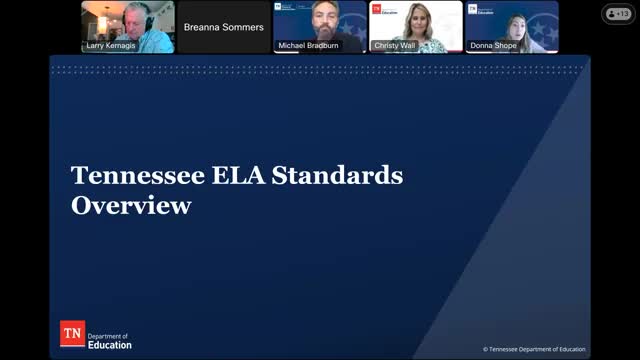Education Department Revises ELA Standards for Grades K-12 to Enhance Clarity and Coherence
September 06, 2025 | State Board of Education, Deparments in Office of the Governor, Organizations, Executive, Tennessee
This article was created by AI summarizing key points discussed. AI makes mistakes, so for full details and context, please refer to the video of the full meeting. Please report any errors so we can fix them. Report an error »

The State Board of Education in Tennessee convened on September 5, 2025, to discuss significant revisions to the English Language Arts (ELA) standards for K-12 education. The meeting highlighted the importance of these standards in shaping proficient readers and writers, ultimately preparing students for post-secondary education and the workforce.
The committee emphasized a new vertical format for the ELA standards, which organizes skills in reading, writing, speaking, listening, and language across grade levels. This approach aims to illustrate how these skills build progressively from kindergarten through 12th grade, ensuring a cohesive learning experience. The foundational years, K-5, are designed to establish strong literacy skills, while grades 6-12 focus on increasing complexity and sophistication in text and tasks.
A key topic of discussion was the instructional shift necessary to support these standards. The committee underscored the need for regular practice with complex texts and academic vocabulary, as well as grounding reading and writing in evidence from both literary and informational texts. This shift is intended to enhance students' readiness for future academic and career opportunities.
Feedback from educators played a crucial role in shaping the revisions. The committee identified three main areas for improvement: clarification, progression, and coherence. Clarification involves ensuring that the language of the standards is clear and understandable for all educators, while progression focuses on eliminating gaps or redundancies in learning. Coherence ensures that the standards reflect developmentally appropriate expectations and that learning builds logically from one grade to the next.
Specific feedback highlighted the need for clearer wording and alignment across grade levels. For instance, educators pointed out inconsistencies in the language used in standards for different grades, which could lead to confusion among teachers and students. The committee acknowledged that some standards may be perceived as too rigorous for certain students and recommended using high-quality instructional materials and scaffolding techniques to support individualized learning.
As the meeting concluded, the committee expressed a commitment to refining the standards based on the feedback received. The anticipated revisions aim to enhance clarity and alignment, ultimately fostering a more effective educational framework for Tennessee's students. The next steps will involve further collaboration with educators to ensure that the revised standards meet the needs of all learners and support their academic growth.
The committee emphasized a new vertical format for the ELA standards, which organizes skills in reading, writing, speaking, listening, and language across grade levels. This approach aims to illustrate how these skills build progressively from kindergarten through 12th grade, ensuring a cohesive learning experience. The foundational years, K-5, are designed to establish strong literacy skills, while grades 6-12 focus on increasing complexity and sophistication in text and tasks.
A key topic of discussion was the instructional shift necessary to support these standards. The committee underscored the need for regular practice with complex texts and academic vocabulary, as well as grounding reading and writing in evidence from both literary and informational texts. This shift is intended to enhance students' readiness for future academic and career opportunities.
Feedback from educators played a crucial role in shaping the revisions. The committee identified three main areas for improvement: clarification, progression, and coherence. Clarification involves ensuring that the language of the standards is clear and understandable for all educators, while progression focuses on eliminating gaps or redundancies in learning. Coherence ensures that the standards reflect developmentally appropriate expectations and that learning builds logically from one grade to the next.
Specific feedback highlighted the need for clearer wording and alignment across grade levels. For instance, educators pointed out inconsistencies in the language used in standards for different grades, which could lead to confusion among teachers and students. The committee acknowledged that some standards may be perceived as too rigorous for certain students and recommended using high-quality instructional materials and scaffolding techniques to support individualized learning.
As the meeting concluded, the committee expressed a commitment to refining the standards based on the feedback received. The anticipated revisions aim to enhance clarity and alignment, ultimately fostering a more effective educational framework for Tennessee's students. The next steps will involve further collaboration with educators to ensure that the revised standards meet the needs of all learners and support their academic growth.
View full meeting
This article is based on a recent meeting—watch the full video and explore the complete transcript for deeper insights into the discussion.
View full meeting
